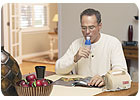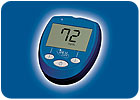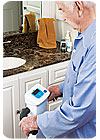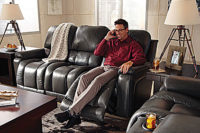
“There’s no place like home.” Most hospital patients would agree with that famous line uttered by Dorothy in “The Wizard of Oz.”
Numerous studies and statistics show that people heal faster and better when they are in familiar, comfortable surroundings. That’s why the home healthcare market has skyrocketed in recent years.
Rising healthcare costs have created a huge demand for safe, lightweight, easy-to-operate medical devices that can be used outside hospitals, medical clinics and nursing homes. Products range from dialysis systems and advanced wound care products to respiratory therapy devices and remote patient monitoring systems.
“[These] technologies have been shown to be effective in helping to manage chronic disease, post-acute care and monitoring the safety of older adults,” says David Lindeman, director of the Center for Technology and Aging, a nonprofit organization that aims to improve the quality and cost-effectiveness of long-term care services. “[They] can help slow the progression of chronic disease, speed recovery after discharge from an acute care setting and help vulnerable adults avoid injuries.”
The U.S. Food and Drug Administration (FDA) defines a home-use device as “a medical device intended for users in a nonclinical or transitory environment . . . managed partly or wholly by the user . . . .”
“Both providers and patients are searching for affordable ways to enable individuals to avoid the inconvenience, cost and risk associated with trips to the doctor’s office for routine care or monitoring,” says Valerie Steinmetz, program director at the Center for Technology and Aging. “As technology has made the convenience of in-home monitoring easier, increasingly providers and patients are using these tools to monitor glucose levels, blood pressure, weight and other vital signs that might trigger the need for intervention.
“Remote patient monitoring devices could reduce U.S. healthcare costs by nearly $25 billion over the next 25 years, if they were more widely used by patients with certain chronic diseases,” Steinmetz points out. For instance, “getting help quickly after a fall (the leading cause of injury deaths among older adults) reduces the risk of hospitalization by 26 percent.”
Medical device manufacturers in numerous product niches are scrambling to tap into the market, which is expected to grow dramatically over the next two decades. The Baby Boom generation is aging, and they want to live in their own homes for as long as possible. According to BCC Research, the global home medical equipment market will grow from $18 billion in 2010 to $24 billion in 2015.
Demographic and attitudinal shifts in the healthcare industry, such as a trend toward shorter hospital stays, are reinforced by technological developments, such as state-of-the-art sensors, touchscreen controls and wireless monitoring devices. Economic trends, such as the rising cost of institutional care, and a growing receptivity to home health care among physicians and insurers, are also stimulating demand.
Because of the growing use of in-home devices, the FDA recently announced a new initiative “to ensure that caregivers and patients safely use complex medical devices in the home.” Currently, the FDA does not have a clear regulatory pathway that describes the unique factors that manufacturers should take into consideration when designing, testing and labeling products intended for home use.
“Using complex medical devices at home carries unique challenges,” claims Jeffrey Shuren, M.D., director of the Center for Devices and Radiological Health. “Caregivers may lack sufficient training, product instructions may be inadequate or overly technical, and the home environment itself may pose environmental or safety hazards that can affect the product’s functioning.”
Potential at-home risks include space limitations, the presence of children or pets, and electromagnetic interference. Other environmental issues that medical device engineers must consider include variables such as temperature, vibration, utilities requirements and electronic connections.
The FDA’s Home Use Initiative will develop guidance for manufacturers and put in place measures to encourage safe use of devices. “[It] will help address the potential challenges, providing greater protection and awareness for patients who are being cared for in the home,” says Shuren.
“As a result of this initiative, companies with new products already in development may need to modify [their] existing development processes,” notes Denny Treu, vice president of research and development at NxStage Medical Inc., which manufactures a product called System One, the only hemodialysis machine cleared for home use by the FDA. “I believe it will take a fair amount of time to sort all this out.”

Unique Differences
At-home devices typically function the same way as traditional medical devices used in hospitals and medical offices. However, they are typically more portable and less complex.“In-home products are smaller in size and weigh less than devices used in doctor’s offices, hospitals or rehab centers,” says Zack Craft, vice president of rehabilitation technology and complex care at Total Medical Solutions, a firm that coordinates home health care products and services for the workers’ compensation industry.
“In addition, prices have come down and devices are becoming easier to use,” says Craft. “For instance, new wound [vacuums] are as small as Sony Walkmans. That gives patients more mobility and makes it easier to use [the devices] in their homes.”
In the case of in-home ventilators, the equipment is significantly smaller and less complex than devices traditionally found in hospitals. They are usually easier to maintain, because they have less tubing and fewer parts, such as connectors, to worry about.
“Connectors should be easy to understand and use, whether by professionals or by the consumer at home,” says Jim Pisula, vice president of marketing at Value Plastics Inc., a company that manufactures quick-connect fittings and other components. The company recently developed a connector with at-home applications in mind.
“The SBL Series quick-connect fittings are intended to take the guesswork out of in-hospital and consumer-operated medical equipment,” Pisula points out. “Every aspect of the [product]-from the color selections to the quick-snap fitting-was intentionally designed to cut down on the likelihood of human error and ultimately provide an added level of security for health care applications.”
In addition to being easier to use, medical devices used at home need to be more durable than products intended for healthcare settings. They need to be easy to lift and transport, yet tough enough to withstand being banged into cabinets and car doors or dropped on hard floors.
“These products need to be used by patients with a wide range of conditions and limitations,” notes Jason Goldberg, president of Ideal Life, a company that provides remote health monitoring systems used for treating chronic illnesses such as congestive heart failure, hypertension, diabetes, asthma and obesity.
“[At-home devices] must fit easily into the patient’s daily routine,” adds Goldberg. “And, because they are used daily, they need to be durable and reliable. If a device frequently breaks down, patients will simply stop using it and convincing them to try a new [device] will become more difficult.”

Design Challenges
Medical device engineers must consider the needs of both health care professionals and patients when designing products for in-home applications. Sometimes, those needs conflict with each other.
“Physicians and nurses want equipment that is easy for the patient to understand and use,” says Amy Korn-Reavis, coordinator of A.W.A.K.E.Orlando, a support group for people with sleep disorders. “This reduces the issues with nonuse and complications. Some physicians also like online monitoring so they are able to review a patient earlier in the initial use period to see if they are doing well and can solve problems sooner.
“Patients want equipment that is easy to understand, small and aesthetically pleasing,” adds Korn-Reavis, who has been a respiratory therapist for the last 25 years and has seen a lot of changes in the way that in-home devices are designed. “They also want the equipment to be as comfortable as possible.”
“Traditionally, medical devices are complex products that are used by highly trained professionals,” says Len Czuba, president of Czuba Enterprises Inc., a medical device design firm. “With in-home products, engineers must rethink who is using the devices.
“Any device used in a home setting must be foolproof so that any person can easily understand how it works,” warns Czuba. “Older patients often have poor eyesight and their ability to move may be limited. Arthritis often restricts hand strength and tactile coordination.” Other limitations include reduced physical strength, stamina and hearing.
“Continuous positive airway pressure (CPAP) machines [which are used to treat sleep apnea] are now quieter and have algorithms that help match breathing patterns more closely,” Korn-Reavis points out. “The machines are also much nicer looking today. One of the new ones has a built-in alarm clock. Another looks similar to books sitting on a night stand. The masks [that are attached to] the machines are becoming more user-friendly, as well.”
Increasingly, people with chronic illnesses travel for business and take vacations. “People don’t want the device to be debilitating,” says Czuba. “They want to maintain active lifestyles and take their medical devices along on cruises.”
As a result, medical device engineers are focusing more attention on the mobility of at-home devices to ensure that they can go where and when patients want to. For instance, oxygen concentrators have gone mobile.
“The small, portable concentrators allow people to travel easier because they are able to be plugged in when the person reaches their destination,” says Korn-Reavis. “It helps to eliminate bringing multiple oxygen canisters when they travel.”
A good example is the EverGo concentrator from Philips Respironics. It weighs less than 10 pounds and features an 8-hour battery. It is even federally approved for in-flight use on commercial airlines.
Because in-home medical devices need to be portable yet robust, plastic is widely used for housings and bodies. “Devices need to be lightweight so patients-particularly the elderly, ill or disabled-or their caregivers can lift, move and operate them without assistance,” says Tom O’Brien, health care product marketing manager at SABIC Innovative Plastics. “Plastics can significantly reduce weight and mass when used as replacements for metal and other traditional materials.
“With the expansion of home health care, [engineers] are focusing on greater ergonomics and aesthetics to make devices comfortable and attractive for consumers,” O’Brien points out. “An attractive appearance makes it less intrusive in the home setting. End users want devices that resemble pieces of furniture and look good in a living room or bedroom.
“The ability to mold complex shapes and to consolidate parts are important in creating eye-catching ergonomic designs,” adds O’Brien. Unlike other materials, plastics can be colored and given different surface textures and finishes that blend with home furnishings.
Hospitals are not as concerned with aesthetics. “They also have rigid cleaning and sterilization processes, but that’s often not the case with home health care,” says O’Brien. “Ease of maintenance is important when designing new products. Plastics are easy to keep clean and are resistant to common household cleansers.”
“Many antimicrobial materials are being offered, which lend themselves to in-home medical devices,” adds Czuba, who is past president of the Society of Plastics Engineers. “Contamination and sterility are big concerns as more devices go home with patients. Anything that can help eliminate surface bacteria is worth considering.”
Most of the plastic components used to assemble in-home medical devices are bonded together. “Ultraviolet, light-curable adhesives are popular with manufacturers, because they offer speed and economy,” note Kyle Rhodes, medical market segment manager at Dymax Corp. “We see a lot of acrylics and polycarbonates used for plastic housings.”
According to O’Brien, polycarbonates are ideal for in-home devices because they offer impact durability and high flow for thin-wall molding, in addition to optical clarity. The material is also ideal for ultrasonic welding applications.
“One of the most promising areas is the evolution of plastic compounds,” says O’Brien. “Compounds can deliver exceptionally high performance, including mechanical strength, lubricity, wear resistance and dimensional stability to facilitate tight tolerances for device specifications.”
To learn more about in-home medical device trends, click www.assemblymag.com and search for these articles:
- New Devices Will Drive Demand for Home Healthcare.
- Telehealth Market Takes Off.
ASSEMBLY ONLINE
For more information on medical device assembly, visit www.assemblymag.com to read these articles:*Tackling Tubing.
*The Human Side of Medical Device Assembly.
*Zap! Lasers Weld Medical Devices.


